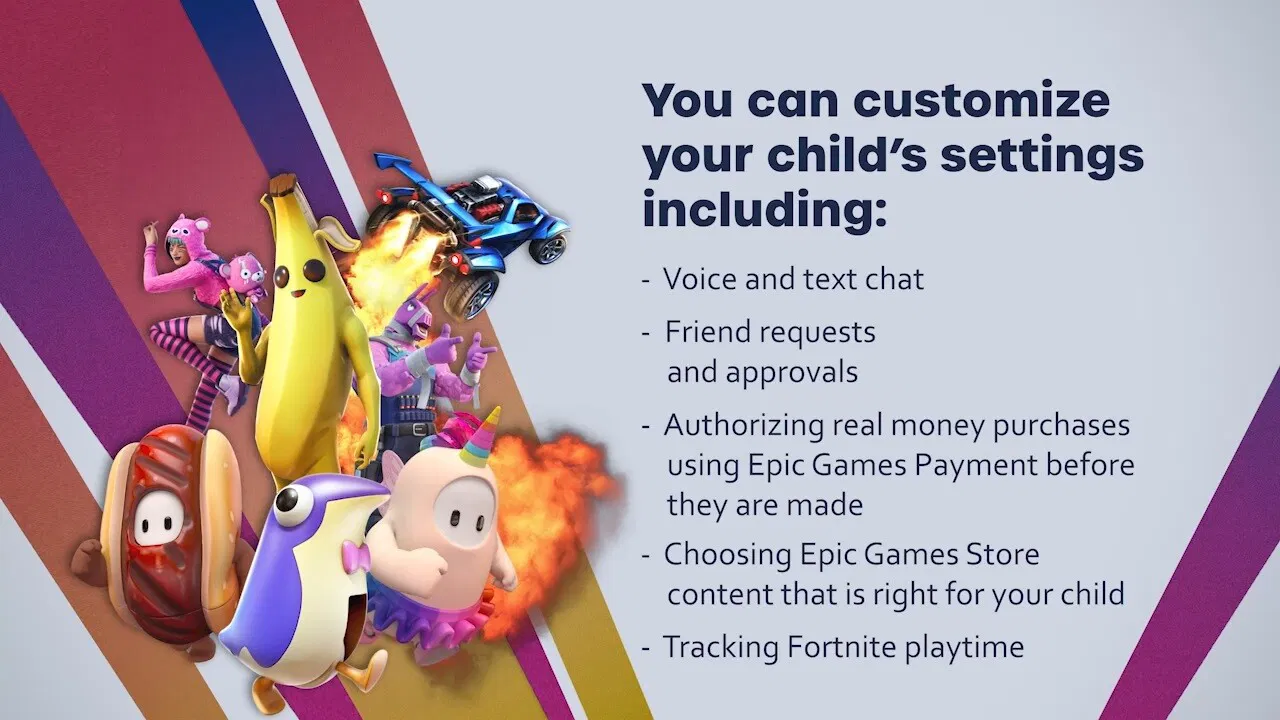Even years after its release, Fortnite still stands as the online “battle royale” game of choice, with millions of younger gamers packing its servers every month—along with fair share of scammers who want to target them both in and out of the game. What makes Fortnite such a proverbial hunting ground for scammers? The answer lies in an in-game economy—one fueled with its own virtual currency that’s backed by real dollars. As to how all that plays out, that calls for a closer look at the game. Fortnite’s in-game currency, V-Bucks, has become a prime target for cybercriminals. One of the most prevalent threats is the so-called “free V-Bucks generator” scam—a fraudulent scheme that promises players free or discounted V-Bucks in exchange for completing online forms, providing account credentials, or downloading software. These offers are entirely illegitimate. No third-party service can generate V-Bucks, and engaging with such sites puts users at significant risk of credential theft, malware infection, and financial fraud.
What is Fortnite?
Fortnite is player-versus-player game where up to 100 players fight as individuals, duos, or squads of up to four, battle on a cartoon-like island where the playable area increasingly shrinks as the game goes on. Along the way, players gain weapons and items that by rummaging through “loot boxes” or through bundles of loot left behind by eliminated players. Fortnite has several game modes, yet the most popular is the “battle royale” mode described here, where the last player, or team, left standing wins.
Is Fortnite free to play?
On the surface, Fortnite is free to play. However, money quickly enters the picture with Fortnite’s in-game currency known as V-Bucks. Players pay real money to purchase different amounts of V-Bucks through the Fortnite Item Shop or through official Fortnite V-Bucks gift cards available in stores and online.
Players use V-Bucks for all kinds of in-game purchases, notably outfits and game avatars known commonly as “skins” based on pop-culture icons like Marvel superheroes and popular singers, along with other game weapons and items. Further, players use V-Bucks to purchase “Battle Passes” that give them access to further in-game purchases and rewards. Finally, players can also purchase “Loot Llamas,” which are bundles of items, skins, and weapons as well (which players can also acquire these through gameplay to some degree).
And that’s where scammers enter the picture. Because wherever money changes hands online, scammers are sure to crop up. And with Fortnite in particular, players are more than willing to pay for V-Bucks, which can turn unwary kids into targets.
What are Fortnite scams, and what do they look like?
In all, players love spending V-Bucks because it lets them create custom avatars loaded with unique items. This makes up a big part of the game’s appeal above and beyond the gameplay itself, to the point where players sporting rarer skins and items take on the air of status symbols.
Bad actors out there do their best to capitalize on this mix of customization, status, and money with several types of scams designed to lure in young gamers. Put plainly, the game’s economy gives scammers a powerful emotional hook they can set—the drive to stand out on the battlefield is high.
Three of the most common Fortnite scams include:
Phishing scams
Just like shopping scams, fake ticket scams, and the like, these scams lure children into clicking links to phishing sites that promise in-game rewards, items, and discounted V-Bucks—but steal credit and debit card info. Young gamers might come across these links in search, yet YouTube has been rife with links to Fortnite scams as well. An examination of domains such as 750ge.com and ggfn.us reveals the use of established phishing methodologies coupled with malware delivery systems. These sites leverage Fortnite’s widespread appeal to attract users seeking free premium content, employing social engineering techniques that mirror those seen in Roblox-related scams and other forms of online fraud.
Social engineering scams
Scammers pose as friendly gamers and build up trust over time, only to betray that trust by asking children to share personal info, passwords, or credit card numbers for “discounted” V-Bucks or items. Some also get children to download malware, promising that the (harmful) app “generates” V-Bucks or gives them “upgrades” of some kind.
Account takeovers and ransoms
Also under the guise of providing items, upgrades, or V-Bucks, scammers persuade children into handing over their login info. This can give them access to personal and financial info contained in the Epic Games Launcher. Further, because some players have spent a great deal of time and money on their account, some scammers hold hijacked accounts for ransom—demanding payment for the return of the account. As it is with any kind of ransomware or ransom attack online, payment is no guarantee that the scammer will return the account.
How to Secure Your Epic Games Account
When it comes to protecting your Fortnite and Epic purchases, a few disciplined habits go a long way. Follow the guidance below to significantly reduce account-takeover risk and streamline recovery if something goes wrong.
Use Unique Passwords
Use a password that you don’t use anywhere else. Credential-stuffing attacks rely on recycled passwords from other breaches; a unique, long passphrase (ideally 14+ characters) blocks that common tactic. Consider a reputable password manager to generate and store complex credentials safely.
Enable Two-Factor Authentication (2FA)
Turn on 2FA so a one-time code is required at sign-in, stopping most unauthorized logins even if a password leaks. Epic supports email, SMS, and authenticator-app methods—use an app whenever possible for stronger protection. Note: 2FA is required for certain programs (e.g., tournaments, Support-A-Creator) and is strongly recommended for all players.
Secure and Verify your Email Address
Your email is the recovery backbone for your Epic account. Use an email you’ll keep long-term, enable that mailbox’s own 2FA, and verify the address within Epic. A verified, secured email makes account recovery faster and helps Player Support confirm ownership if there’s suspicious activity.
Link Your Social Accounts for Extra Security
Linking trusted single-sign-on options (e.g., Google) can simplify logins without creating yet another password—provided those social accounts are themselves protected with unique passwords and 2FA. Treat your SSO accounts as keys: if they’re well-secured, they reduce friction without sacrificing safety.
Keep Your Devices Secure
Good account security starts with healthy devices. Keep operating systems and browsers up to date, use reputable antivirus/anti-malware, and avoid installing unknown software or extensions. A compromised device can capture keystrokes and tokens regardless of how strong your password is.
Don’t Buy or Share Accounts
Buying, selling, or sharing accounts violates policy and exposes you to scams, chargebacks, and permanent loss of access. If someone else knows your password—or if ownership is disputed—support may not be able to help. Keep your credentials private and your account strictly personal.
Don’t Trust Suspicious Offers
Ignore sites and messages promising free or discounted V-Bucks, skins, or creator perks. These are common phishing and malware lures that mimic Epic branding to steal credentials or install harmful software. Only transact through official Epic channels and in-game menus.
If You Suspect Compromise
If you can still log in: immediately reset your email password, then your Epic password, and enable 2FA. Review recent logins and unlink unknown devices. If you can’t log in: work through Epic’s recovery steps starting with your email account and Epic password reset. Have purchase details handy to verify ownership.
What are the parental controls for Fortnite?
With many Fortnite scams, scammers need a way to speak with your child, ideally in the game itself. Fortunately, Fortnite has several parental controls that make it far more difficult for scammers to approach them and that give you further control over payments made through the platform.
Here are a few of the things you can manage from Fortnite’s parental controls:
Social permissions
This lets you manage your child’s online social interactions across Epic’s experiences and games by setting permissions for friend requests, voice and text chat, and mature language filtering.
Purchasing settings
Here you can set permissions to help prevent unauthorized payments while using Epic Games payment services.
Age-rating restrictions
You can manage which experiences your child can access in Fortnite, and which games your child can access in the Epic Games Store based on age ratings.
Time limit controls & time reports
Set time limits and view the total time your child spends in Fortnite and Unreal Editor for Fortnite (UEFN) each week. Choose if you want to receive email reports for your child’s time spent in Fortnite and UEFN.
Should I trust a website that’s offering free V-Bucks?
As Epic Games states, avoid trusting any offers for Epic Games products—such as free titles or V-Bucks that come from external or unverified sites, as they are likely scams. Legitimate promotions are only shared through the Epic Games Store, the official Epic Games website, or their verified social media channels, so if you don’t see it there, it’s not real.
Additionally, for parents of younger players …
Fortnite offers what Epic Games calls “Cabined Accounts,” a safer space that disables voice and text chat, while also disabling the ability to pay for items with real money. (In the U.S., Cabined Accounts are for children under 13 years old. Elsewhere, under that country’s age of digital consent.) Players with Cabined Accounts can still play titles from Epic Games like Fortnite, Rocket League or Fall Guys, but won’t be able to access certain features such as voice chat until their parent or guardian provides consent.

Source: Epic Games
What other parental controls can you set to keep your kids safe on Fortnite?
Be aware, though. The parental controls listed above only apply to games on the Epic Games platform. That means your child may still be able to access voice chat using the chat system built into the gaming console or device they’re playing on. So you’ll want to check out the parental controls on their console or device as well, which we’ve listed below:
PlayStation
PlayStation® 5 parental controls and PlayStation® 4 parental controls
Xbox
Nintendo Switch
Nintendo Switch™ parental controls
Windows
iOS
Google Play
More ways you can protect your kids from Fortnite and online game scams
Make sure your kids know that virtual money is often real money.
Whether it’s Fortnite V-Bucks or many of the other virtual currencies used in online games, many are tied back to real dollars. It costs real money to buy them. Ultimately, the same goes for the in-game purchases they make. Younger gamers don’t always make this connection, which is how we get the occasional headline story about a grade-school child who racks up a multi-thousand-dollar credit card bill. Have a sit-down with your child and help them understand this connection between “virtual” money and “real” money. And with that, you can have a follow-on chat about an allowance for online game purchases (which you can often set using a game’s parental controls). Do note, Epic Games does not offer legitimate V-Bucks generators outside their official platforms. Any site claiming otherwise is operating a fraud scheme that poses significant security risks to users.
Set the parental controls for the games they play.
We’ve outlined what Fortnite offers by way of parental controls, as well as the parental controls offered on several top gaming platforms. Once more, note that you’ll want to set parental controls on the any of the games your children play that include online chat or purchases. Granted, the controls vary from game to game, but a quick web search will let you know what your options are. In some cases, as with Fortnite, gaming companies have entire websites dedicated to parental controls and overall child safety.
Help your kids know the difference between “friends” in games and friends in real life.
As we outlined above, many scammers try to trick young gamers into thinking they’re a friend—when in fact any kind of “friendship” is part of a scam. Make sure you let them know it’s always okay to speak with you or another trusted adult if a “friend” asks them for personal info or anything that has to do with money. The same goes for asking them to chat on other apps outside the game, such as Whatsapp, or to meet up in person. Understandably, the answer to questions like these is always “no.” Note that some games and platforms let you report accounts for behavior like this. Use those tools as needed.
Use a credit card to pay for online games.
In the U.S., the Fair Credit Billing Act allows you to dispute charges. Additionally, some credit cards offer their own anti-fraud protections that can help you dispute a billing. Further, if your credit card offers online account alerts for when a purchase is made, set that up so you can track what your children are spending online. Lastly, use credit monitoring to track any unusual purchases. Credit monitoring like ours provides timely notifications and guidance so you can take action to tackle identity theft.
Get a scam detector working for you.
Phony sites, emails, texts, and on and on and on—scammers put them all into play. Yet a combination of features in our McAfee+ plans can help you and your children spot them.
McAfee’s Scam Detector helps you stay safer with advanced scam detection technology built to spot and stop scams across text messages, emails, and videos. Likewise, our Web Protection will alert you if a link might take you to a sketchy site. It’ll also block those sites if you accidentally tap or click on a bad link.













